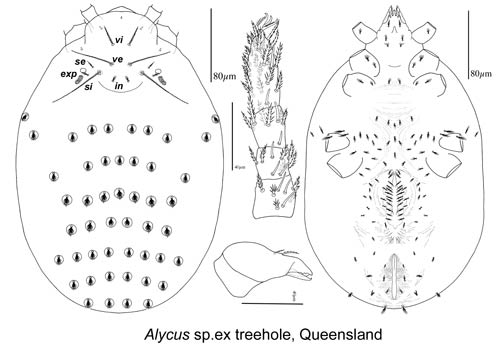
Home | Endeostigmata & Sphaerolichida Home | Glossary
Alycus
Alycus Koch, 1841 (Alychus Canestrini & Fanzago, 1877: 168; also Alichus)
Type species: Alycus roseus CL Koch 1842 (= Pachygnathus dugesi Grandjean 1937)
Alycus occidentalis Womersley 1944 - Australia; Alycus trichosus (Grandjean) Europe; Alycus marinus (Schuster) Europe; Alycus denasutus (Grandjean) Europe.
DIAGNOSIS. Prodorsum with 2 pairs of filiform trichobothria (si, ve) and 4 pairs of setae (vi, se, in, exp); naso reduced to small nub, median eye absent; lateral eyes present. Rutella present; chelicerae chelate-dentate, each with 2 setae. Opisthosoma usually hypertrichous, but sometimes only sparsely so; 3 pairs of genital papillae.

REMARKS. Species of Alycus are fairly common and only likely to be confused with species of Amphialycus, which have retained a median eye. Some species of Alycus feed on nematodes (Walter 1988), which usually do not form visible gut contents, but others have gut boluses with fungal material.
References
Grandjean F. 1936. Le genre Pachygnathus Dugês (Alycus Koch) (Acariens). Ire partie. Bull. Mus. nat. hist. 8 (ser. 2):398-405.
Grandjean F. 1937a. Le genre Pachygnathus Dugês (Alycus Koch) (Acariens). Deuxième partie. Bull. Mus. nat. hist. 9 (ser. 2): 56-61, figs 1-3.
Grandjean F. 1937b. Le genre Pachygnathus Dugês (Alycus Koch) (Acariens). Troisième partie. Bull. Mus. nat. hist. 9 (ser. 2):134-138, figs 4-5.
Grandjean F. 1937c. Le genre Pachygnathus Dugês (Alycus Koch) (Acariens). Quatrième partie. Bull. Mus. nat. hist. 9 (ser. 2):199-205, figs 6-8.
Grandjean F. 1937d. Le genre Pachygnathus Dugês (Alycus Koch) (Acariens). Cinquième et dernière partie. Bull. Mus. nat. hist. 9 (ser. 2):262-269, fig 9.
Halliday, B. 1998. Mites of Australia, A Checklist and Bibliography. Monographs on Invertebrate Taxonomy Vol. 5. CSIRO Publishing, Collingwood.
Hammen L van der. 1969. Notes on the morphology of Alycus roseus C.L. Koch. Zool. Med. 43: 177-202.
Judson, M. 2000. Nomenclatorial problems assoicated with the names Alycidae Canestrini & Fazago, 1877 and Pachygnathidae Kramer, 1877 (Acari). Mem. Soc. Entomol. ital. 78 (2): 533-540.
Kethley JB. 1982. Endeostigmata. pp. 118-120, In: Parker SP (ed.) Synopsis and classification of living organisms. McGraw-Hill, NY.
Kethley JB. 1990a. Acarina: Prostigmata (Actinedida). pp. 667-756, In: DL Dindal (ed), Soil Biology Guide. John Wiley & Sons, Brisbane.
Kethley J. 1990b. The prelarva of Alycus roseus Koch (Bimichaeliidae: Acariformes: Acari). Canadian Journal of Zoology 68(5) 1990: 1058-1061
Kethley, J. 1991. Probable tritonymphal sexual dimorphism in Alycus roseus (Bimichaeliidae: Acariformes: Acari). Journal of Entomological Science 26(1) 1991: 130-135
Kethley, J. 1992. The prelarva of Alycus roseus Koch (Bimichaeliidae: Acariformes: Acari). Canadian Journal of Zoology 68: 1058–1061.
Krivolutski DA, Livshits IZ, Mitrofanov VI. 1978. Pachygnathidae, pp. 91-96, In: Gilyarov, M.S. [Ed.] [Identification key of soil inhabiting mites. Trombidiformes.] Nauka, Moscow 1978: 1-270.
Thor S & Willman C. 1941. Acarina – 71a. Eupodidae, Penthalodidae, Penthaleidae, Rhagidiidae, Pachygnathidae, Cunaxidae. Das Teirreich 71: 1-186.
Walter DE. 1988. Predation and mycophagy by endeostigmatid mites (Acariformes: Prostigmata). Experimental & Applied Acarology 4: 159-166.
Walter, D.E. and Proctor, H.C. 1999. Mites: Ecology, Evolution and Behaviour. University of NSW Press, Sydney and CABI, Wallingford. ISBN 0 86840 529 9
Womersley H. 1944. Australian Acarina, families Alycidae and Nanorchestidae. Transactions of the Royal Society of South Australia 68: 133-143.
Zakhvatkin AA. 1949. New representatives of apparently segmented mites (Acarina: Pachygnathidae). Ent. Obozer. Moscow 30: 291-295.